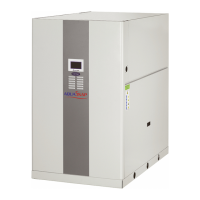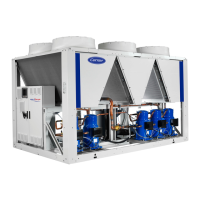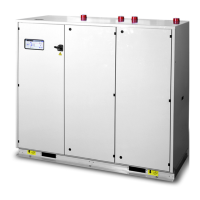66
20.3 - Refrigerant undercharge
If there is not enough refrigerant in the system, this is indicated
by gas bubbles in the moisture sight glass.
If the undercharge is signicant, large bubbles appear in the
moisture sight glass, and the suction pressure drops. The
compressor suction superheat is also high. The machine must be
recharged after the leak has been repaired.
Find the leak and completely drain the system with a refrigerant
recovery unit. Carry out the repair, leak test and then recharge
the system.
IMPORTANT: After the leak has been repaired, the circuit must
betested,withoutexceedingthemaximumlow-sideoperating
pressure shown on the unit name plate.
The refrigerant must always be recharged in the liquid phase into
the liquid line. The refrigerant cylinder must always contain at least
10% of its initial charge. For the refrigerant quantity per circuit,
refer to the data on the unit name plate.
20.4 - Refrigerant guidelines
Refrigeration installations must be inspected and maintained
regularly and rigorously by specialists. Their activities must be
overseen and checked by properly trained people. To minimise
discharge to the atmosphere, refrigerants and lubricating oil must
be transferred using methods which reduce leaks and losses to
a minimum.
- Leaks must be repaired immediately.
- If the residual pressure is too low to make the transfer alone,
a purpose-built refrigerant recovery unit must be used.
- Compressor lubricating oil contains refrigerant. Any oil
drained from a system during maintenance must therefore
be handled and stored accordingly.
- Refrigerant under pressure must never be discharged to the
atmosphere.
Before opening a refrigerant circuit, purge the circuit and consult
the pressure gauges.
Change the refrigerant after an equipment failure, following a
procedure such as the one described in NF E29-795 or carry out
a refrigerant analysis in a specialist laboratory.
If the refrigerant circuit remains open for longer than a day after
an intervention (such as a component replacement), the openings
must be plugged and the circuit must be charged with nitrogen
(inertia principle). The objective is to prevent penetration of
atmospheric humidity and the resulting corrosion on the internal
walls and on unprotected steel surfaces.
20.5 - Leak detection
Never use oxygen or dry air, as this would cause a risk of re or
explosion.
- Carry out a leak detection test on the whole system using
the following methods: pressure test using dehydrated
nitrogen or a mixture of nitrogen and refrigerant used for the
system, helium leak test.
- Connect the compressor to the system by opening the valves.
- The duration of the test must be sufcient to guarantee the
absence of very small leaks in the circuit.
- Use specic tools, designed for leak detection.
- The low-pressure side test pressure must not exceed
pressure Ps indicated on the compressor and unit name
plates.
- If there is a leak, repair it and carry out the leak detection test
again.
20.6 - Evacuation
To evacuate the system, observe the following recommendations:
Connect the vacuum pump to the high (HP) and low-pressure (LP)
side for evacuation of the complete circuit. Never use the
compressor as a vaccum pump.
All units are equipped with valves with 3/8” SAE connections on
the suction, discharge and liquid lines, permitting the connection
of large-diameter exible pipes limiting the pressure drops for the
evacuation.
1. The vacuum level achieved must be 0.67 mbar (500 µm Hg).
2. Wait 30 minutes.
3. If the pressure increases rapidly, the system ist not leak-tight.
Localise and repair the leaks. Restart the evacuation procedure
and repeat steps 1, 2, etc.
4. If the pressure increeases slowly, this indicates that moisture
is present inside the system. Break the vacuum with nitrogen
and restart the evacuation procedure (steps 1, 2, etc.).
5. Repeat the evacuation procedure (steps 1, 2); a vacuum level
of 0.67 mbar (500 µm Hg) must be achieved and maintained
for four hours.
This vacuum level must be measured at one of the system
connections and not at the vacuum pump pressure gauge.
ATTENTION: Do not use a megohmmeter and do not place
any stress on the compressor motor when the system has
been evacuated. There is a risk of internal short circuits
between the motor windings.
Do not use additives for leak detection. Do not use CFCs/
HCFCs as tracer uids for leak detection.
20.7 - Recharging liquid refrigerant
CAUTION: The units are charged with liquid R-410A
refrigerant.
With high-pressure R-410A refrigerant the unit operating pressure
is above 4000 kPa (40 bar). Special equipment must be used when
working on the refrigerant circuit (pressure gauge, charge transfer,
etc.).
All checks must be pressure tests, and the appropriate pressure/
temperature ratio table must be used to determine the corresponding
saturated temperatures (saturated bubble point curve or saturated
dew point curve).
Leak detection is especially important for units charged with
refrigerant R-410A. Depending on whether the leak occurs in the
liquid or in the vapour phase, the proportion of the different
components in the remaining liquid is not the same.
NOTE: Regularly carry out leak checks and immediately repair
any leak found.
20 - MAINTENANCE

